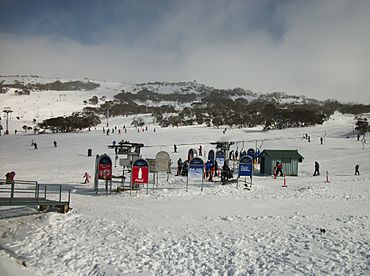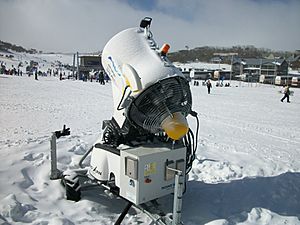Smiggin Holes, New South Wales facts for kids
Quick facts for kids Smiggin HolesNew South Wales |
|
|---|---|

Smiggin Holes Ski Resort, 2010
|
|
| Established | 1939 |
| Postcode(s) | 2624 |
| Elevation | 1,680 m (5,512 ft) |
| Location |
|
| LGA(s) | Snowy Monaro Regional Council |
| State electorate(s) | Monaro |
| Federal Division(s) | Eden-Monaro |
Smiggin Holes is a small village in the Snowy Mountains of New South Wales, Australia. It is a popular spot for skiing and snowboarding. This village is part of the huge Perisher Ski Resort, which is one of the biggest ski areas in the Southern Hemisphere.
Smiggin Holes is located inside Kosciuszko National Park. This means you usually pay a small fee to enter the park. During winter, cars are not allowed to stay overnight in the village.
What's in a Name?
The name "Smiggin Holes" comes from Scotland! Long ago, farmers would put rock salt in this area for their cattle. Hundreds of cows would come to lick the salt, and their hooves would make dents in the ground. These dents would fill with water, creating small puddles. People called these puddles "the smiggin holes."
Skiers first started coming to Smiggin Holes in 1939. It's known as a great place for beginners to learn to ski. The area is quite sheltered, which means it's protected from really bad weather. This makes it a bit warmer and calmer than other parts of the Snowy Mountains.
Skiing and Snowboarding Fun
Smiggin Holes is one of four main areas that make up the Perisher Ski Resort. It sits high up, about 1,680 meters (5,512 feet) above sea level.
Skiing became popular in this area a long time ago. In 1909, a hotel called the Hotel Kosciuszko opened nearby. Later, in 1930, the first Kosciuszko Chalet was built at Charlotte Pass. This made it easier for skiers to reach Australia's highest mountains.
Around 1939, a cafe was set up at Smiggin Holes. Skiers would arrive here by horse-drawn sleighs before heading off to places like Charlotte Pass and Mount Kosciuszko.
How Skiing Grew
A huge project called the Snowy Mountains Hydro-Electric Scheme started in 1949. This project built dams and power stations. It also made it much easier to get around the Snowy Mountains. This helped the ski industry grow a lot, leading to the creation of big resorts like Thredbo and Perisher.
In the 1980s, another major ski area, Mount Blue Cow, was developed. In 1987, a special train called the Skitube opened. It takes skiers from Bullocks Flat right into Perisher Valley and Blue Cow.
Later, the Blue Cow resort joined with Guthega, and then they merged with Perisher-Smiggins. This created the massive Perisher Ski Resort we know today. In 2009, Perisher had 48 ski lifts and covered a huge area, with four main villages: Perisher Valley, Blue Cow, Smiggin Holes, and Guthega.
Smiggin Holes in the News
During the 2002 Winter Olympics, two famous Australian comedians, Roy and HG, had a funny idea. On their TV show, The Ice Dream, they pretended that Smiggin Holes was trying to host the next Winter Olympics in 2010! It was all a joke, but it made many people laugh.



